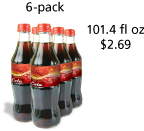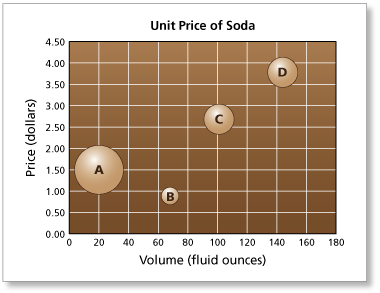-
Compare the unit prices of the products.



-
2-liter bottle: Use


6-pack:

Case:

The 2-liter bottle is significantly less in terms of unit prices. This makes sense because it uses less packaging materials.
Comments (1)These comments are not screened before publication. Constructive debate about the information on this page is welcome, but personal attacks are not. Please do not post comments that are commercial in nature or that violate copyright. Comments that we regard as obscene, defamatory, or intended to incite violence will be removed. If you find a comment offensive, you may flag it.
When posting a comment, you agree to our Terms of Use.Showing 1 commentsSubscribe by email Subscribe by RSSGuest 2 months ago |ZYMUD0 0 -
-
A 20-fluid-ounce bottle of soda sells for $1.50. Find the unit price of the 20-fluid-ounce bottle. Then compare it with the unit price of the 2-liter bottle.



These comments are not screened before publication. Constructive debate about the information on this page is welcome, but personal attacks are not. Please do not post comments that are commercial in nature or that violate copyright. Comments that we regard as obscene, defamatory, or intended to incite violence will be removed. If you find a comment offensive, you may flag it.
When posting a comment, you agree to our Terms of Use. -
A family of 4 drinks about 200 gallons of soda annually. All of the family's soda is purchased in 2-liter bottles instead of 6-packs. How much does the family save per year?



-
Using the results of Exercise 1, the unit prices for 2-liter bottles and for 6-packs are:
2-liter bottle: Use


6-pack:

Using the fact that there are 128 fluid ounces in a gallon, the cost of 200 gallons is:
2-liter bottle:

6-pack:

The family can save
 or about $360 per year by buying the 2-liter size.
or about $360 per year by buying the 2-liter size.Of course, the family could save almost $700 a year by drinking tap water instead of soda.
These comments are not screened before publication. Constructive debate about the information on this page is welcome, but personal attacks are not. Please do not post comments that are commercial in nature or that violate copyright. Comments that we regard as obscene, defamatory, or intended to incite violence will be removed. If you find a comment offensive, you may flag it.
When posting a comment, you agree to our Terms of Use. -
-
A store offers a deal of $10.00 for 4 cases.



- Compare the unit price for four cases with the deal to the unit price for one case without the deal.
- How much do you save per case with the deal?
These comments are not screened before publication. Constructive debate about the information on this page is welcome, but personal attacks are not. Please do not post comments that are commercial in nature or that violate copyright. Comments that we regard as obscene, defamatory, or intended to incite violence will be removed. If you find a comment offensive, you may flag it.
When posting a comment, you agree to our Terms of Use. -
The sizes of the bubbles in the bubble graph represent the unit prices of four sodas. The bigger the bubble, the greater the unit price. Without changing the volume, how does increasing the price affect the size of bubble A?

-
When you move bubble A up, you are increasing its price. Because the volume remains constant at 20 fluid ounces, the unit price is increasing. Consequently, the bubble will get larger as the price increases.
These comments are not screened before publication. Constructive debate about the information on this page is welcome, but personal attacks are not. Please do not post comments that are commercial in nature or that violate copyright. Comments that we regard as obscene, defamatory, or intended to incite violence will be removed. If you find a comment offensive, you may flag it.
When posting a comment, you agree to our Terms of Use. -
-
The sizes of the bubbles in the bubble graph represent the unit prices of four sodas. The bigger the bubble, the greater the unit price. Without changing the price, how does decreasing the volume affect the size of bubble C?

These comments are not screened before publication. Constructive debate about the information on this page is welcome, but personal attacks are not. Please do not post comments that are commercial in nature or that violate copyright. Comments that we regard as obscene, defamatory, or intended to incite violence will be removed. If you find a comment offensive, you may flag it.
When posting a comment, you agree to our Terms of Use. -
The sizes of the bubbles in the bubble graph represent the unit prices of four sodas. The bigger the bubble, the greater the unit price. Which bubble represents the product with the most soda per dollar? Explain your reasoning.

-
Remember that unit prices are represented by bubble sizes.
Large bubbles = Large unit prices
Small bubbles = Small unit prices
When you are looking for the product with the most soda per dollar, you want a small unit price.
Large bubbles = Large unit prices = Less soda per dollar
Small bubbles = Small unit prices = More soda per dollar
So, of the four products shown, brand B gives you the most soda per dollar.
These comments are not screened before publication. Constructive debate about the information on this page is welcome, but personal attacks are not. Please do not post comments that are commercial in nature or that violate copyright. Comments that we regard as obscene, defamatory, or intended to incite violence will be removed. If you find a comment offensive, you may flag it.
When posting a comment, you agree to our Terms of Use. -
-
The sizes of the bubbles in the bubble graph represent the unit prices of four sodas. The bigger the bubble, the greater the unit price. Which bubble represents the product with the least soda per dollar? Explain your reasoning.

These comments are not screened before publication. Constructive debate about the information on this page is welcome, but personal attacks are not. Please do not post comments that are commercial in nature or that violate copyright. Comments that we regard as obscene, defamatory, or intended to incite violence will be removed. If you find a comment offensive, you may flag it.
When posting a comment, you agree to our Terms of Use.





